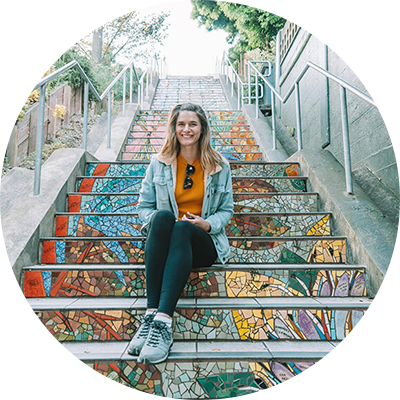TL;DR: Heading to Joshua Tree Naitonal Park? Here are the key takeaways from my Joshua Tree camping guide:
- Joshua Tree has 9 campgrounds including 6 reservable sites and 3 first-come, first-served sites with amenities like fire pits, flush toilets, and dump stations, but no RV hookups or showers.
- Top activities in Joshua Tree National Park include hiking Ryan Mountain, visiting Skull Rock, seeing the spring wildflower bloom, and stargazing at the White Tank Campground.
- The best time to camp in Joshua Tree is in the cooler months from late fall through early spring.
- Campers in Joshua Tree must get permits, stay on designated trails, keep distance from water sources, and cannot hang anything on the protected Joshua trees.
Recently, the number of visitors to Joshua Tree National Park has exploded. The secret is out: the desert is beautiful! But what is the deal with camping in the park?
If you didn’t grow up camping, making a reservation in a national park might seem daunting. Can you camp anywhere you want? Do you need a reservation? What is dispersed camping?
I’ve been to Joshua Tree a few times and think of myself as a national park camping expert.
Below, I’ve created a guide to camping in Joshua Tree to answer all of your desert camping questions. Keep reading if you’re looking for the best Joshua Tree camping experience possible!
Note: this article contains affiliate links, which help run this site at no extra cost to you so I can keep providing free travel advice and tips.
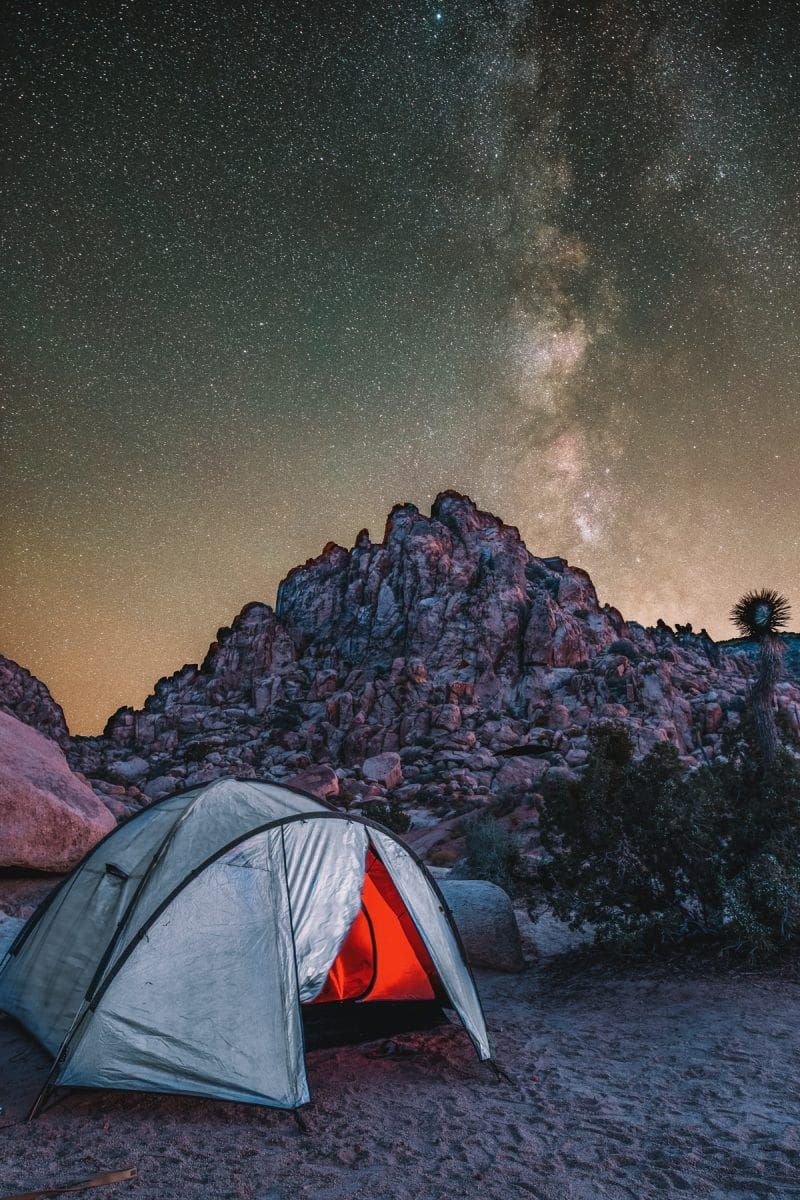
A Quick Glance at Joshua Tree National Park Campgrounds
| Campground | Location | Sites | Toilets | Group | RV |
|---|---|---|---|---|---|
| Black Rock | North Entrance | 99 | Flush | No | Yes, no hookups |
| Jumbo Rocks | Central Joshua Tree | 124 | Pit | No | Yes, no hookups |
| Ryan | Central Joshua Tree | 31 | Pit | No | Yes, no hookups |
| Hidden Valley | Central Joshua Tree | 44 | Pit | No | Yes, no hookups |
| Belle | North park entrance | 18 | Pit | No | Yes, no hookups |
| White Tank | North park entrance | 15 | Pit | No | Yes, no hookups |
| Indian Cove | North Joshua Tree | 101 | Pit | Yes | Yes, no hookups |
| Cottonwood | South Entrance | 62 | Flush | Yes | Yes, no hookups |
| Sheep Pass | Central Joshua Tree | 6 | Pit | No | No |
America the Beautiful Pass
If you’re planning to visit more than 2-3 big national parks in a year, you should consider getting the America the Beautiful Pass.
This pass is sold at REI, costs $80, and will get you into all of the National Park Service sites.
You can also buy the America the Beautiful Pass at any park entrance station that collects fees or online here. The National Park Service sells discounted passes for seniors and veterans.
Get your FREE California Travel Planner – including printable checklists and my favorite two-week itinerary for the state.
Making Reservations for Joshua Tree National Park
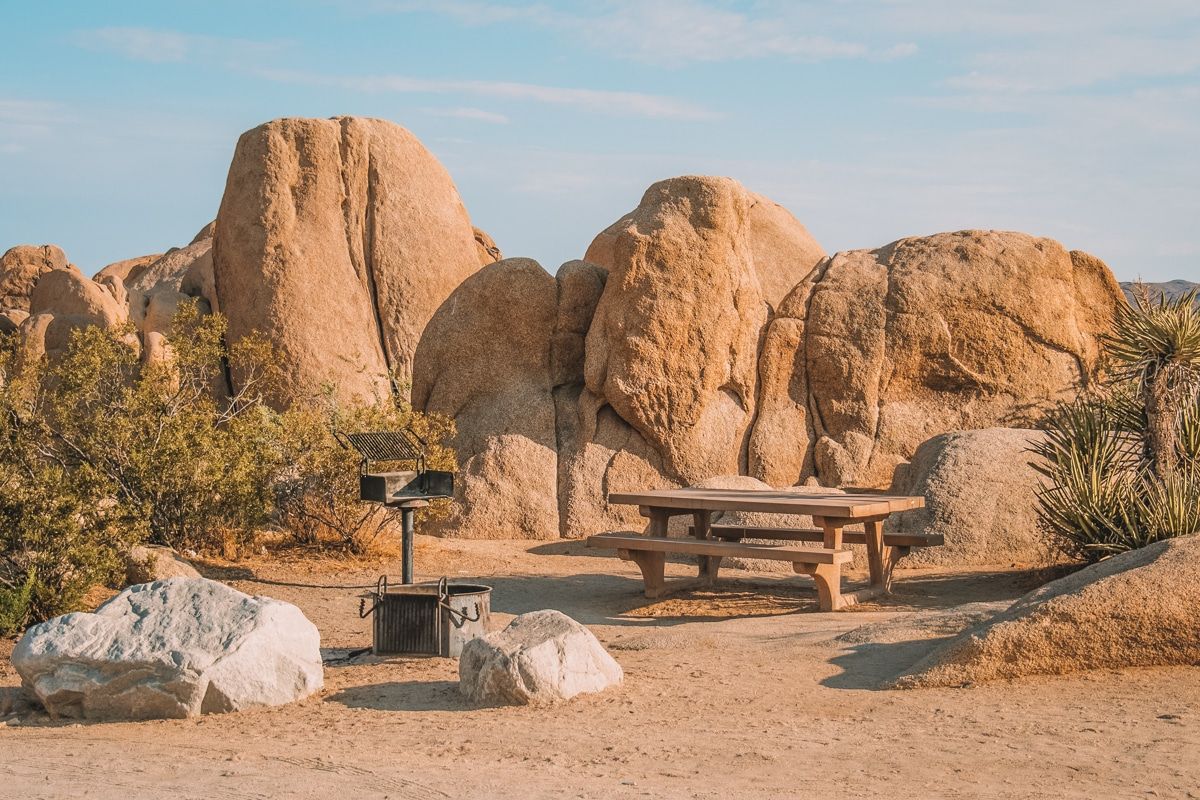
These days, camping reservations for Joshua Tree need to be made many months in advance, especially to snag the best campsites.
Six campgrounds take reservations and open up on a rolling basis six months in advance. Plus, there are three first-come, first-served campgrounds.
If you want to camp on December 10th, you must be ready to pounce on recreation.gov on June 10th at 7 am Pacific Time–sharp.
How to get a Camping Site at Joshua Tree National Park Using recreation.gov.
- Make a profile on recreation.gov. Don’t wait until 7 am on the morning you need to make the reservations because this step takes a few minutes and can make or break your ability to get the site you want.
- Set a reminder on your phone six months ahead of your intended camping trip.
- Log in 10 minutes before 7 am, get ready to select a campsite, and book your site as soon as it opens up.
The six campgrounds that need reservations are Ryan Campground, Indian Cove Campground, Jumbo Rocks Campground, Black Rock Campground, Sheep Pass Group Campground, and Cottonwood Campground.
How to get a First-Come First-Served Campsite at Joshua Tree National Park
The three first-come, first-served campgrounds are Belle, Hidden Valley, and White Tank Campgrounds.
My best advice for getting into one of these first-come, first-serve campsites is to go early in the day and before the weekend if you can.
Often, you have to post your exit day on the post by your campsite. I’ve had success chatting up campers to ask if I can reserve their spot before they head out.
Do I Need a Reservation to get into Joshua Tree?
No, but you do need to pay an entrance fee.
The camping fee doesn’t buy you entrance into the park–even if you’ve already purchased a campsite, you still need to buy the entrance pass to get in.
You can buy the pass at the ranger station at the entrance to the park, or get an America the Beautiful pass ahead of time for easy entry into all of the national parks.
Places to Camp in Joshua Tree National Park
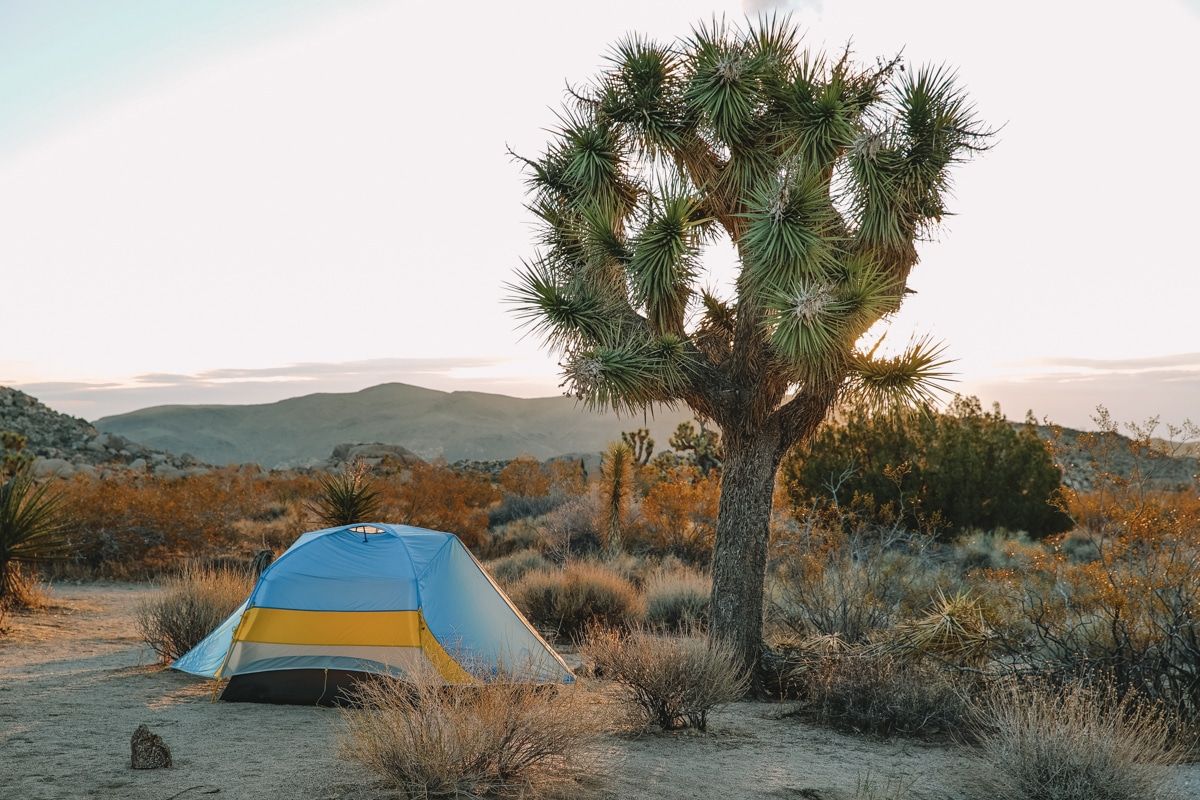
Central Joshua Tree
Joshua Tree’s main area is the north-central portion along Park Boulevard, which is the main east-west artery through the park.
The central Park Boulevard area is an excellent place to camp if you want to be near the Desert Queen Mine Trail, Ryan Mountain, Cap Rock, or Keys View.
The central area of Joshua Tree is also generally the best place to see Joshua Trees.
This area includes Ryan Campground, Sheep Pass Group, and Hidden Valley Campground.
North Entrance
The Northern Entrance to Joshua Tree is closest to Twentynine Palms, CA.
It should be called the East Entrance because, in reality, it’s the park’s easternmost entrance, and isn’t any more “north” than the West Entrance.
The North Entrance area includes Belle Campground, White Tank Campground, and Jumbo Rocks Campground.
Pinto Basin Road, the main north-south artery through the park, begins at the Northern Entrance.
If you like a quieter atmosphere but still want to be close to Twentynine Palms and the action in central J-Tree, consider camping in this area.
West Entrance
The West Entrance is closest to the town of Joshua Tree, CA, so it’s a great place to camp if you want to be close to town.
This area of the park includes the Black Rock Campground. It has the closest access to the Panorama Loop Trail and is another excellent spot to see Joshua trees.
South Entrance
The South Entrance to Joshua Tree is the terminus of Pinto Basin Road. The landscape here is classic Colorado Desert, peppered with numerous short cholla cacti.
Cottonwood Campground is the only campground at the South Entrance. It’s the least busy entrance to the park and affords lots of solitude.
Best Campgrounds in Joshua Tree National Park
Joshua Tree has six reservation campgrounds and three first-come, first-served campgrounds. Below, I’ve listed all the different campgrounds with my favorites on top.
Black Rock Campground
Why it’s worth camping at: It has running water and a designated spot for horse trailers.
Location: North Entrance
Open: Early September-Late May
Number of sites: 99, including 20 equestrian sites and one ADA-accessible site.
Cost: $25
Reservations allowed: Yes, click here to reserve.
Amenities: Flush toilets, fire pits, picnic tables, drinking water, RV dump station, and a horse hitching area but no showers.
Campground map
Black Rock Campground is located on the northwestern edge of the park boundary. To get there, you’ll take Black Rock Canyon Road from the town of Joshua Tree.
In my opinion, Black Rock is the best campground in the park because it’s one of the few with running water and a visitor center.
It also has the highest number of equestrian sites (20) because Black Rock Campground is near the California Riding and Hiking Trail.
Site 61 is one of two ADA-accessible campsites in the park.
Jumbo Rocks Campground
Why it’s worth camping at: It’s the biggest campground in the park and close to Skull Rock.
Location: Central Joshua Tree
Open: All year-round
Number of sites: 124, plus one ADA-accessible site.
Cost: $20
Reservations allowed: Yes, click here to reserve.
Amenities: Pit toilets, fire pits, and picnic tables. No drinking water, no RV hookups, and no showers.
Campground map
Jumbo Rocks Campground is the campground I stayed in last time I was in Joshua Tree and it was lovely!
There are giant boulders everywhere at Jumbo Rocks, and while I’ve heard some people say there aren’t many climbing routes around the campground, I disagree. There were routes everywhere with climbers enjoying them.
This campground is also near Skull Rock, so you don’t have to fight for parking to see one of the most famous rock formations in the park. You can just walk from your site.
Jumbo Rocks is a popular campground, so be sure to plan far in advance if you want to stay here. Additionally, site 122 is ADA accessible.
Ryan Campground
Why it’s worth camping at: Close access to Ryan Mountain and Cap Rock.
Location: Central Joshua Tree
Open: Year-round
Number of sites: 31, plus four designated equestrian sites and three bicycle sites.
Cost: $20
Reservations allowed: Yes, click here to reserve.
Amenities: Pit toilets, fire pits, and picnic table. No drinking water, no RV hookups, and no showers.
Campground map
The centrally located Ryan Campground is a prime location if you plan to hike the Ryan Mountain or Cap Rock trails.
Another thing I like about Ryan Campground is that it’s one of two campgrounds that has equestrian and bike-in sites.
Like most campgrounds in the park, Ryan Campground doesn’t have any water–so be sure to bring your own!
Hidden Valley Campground
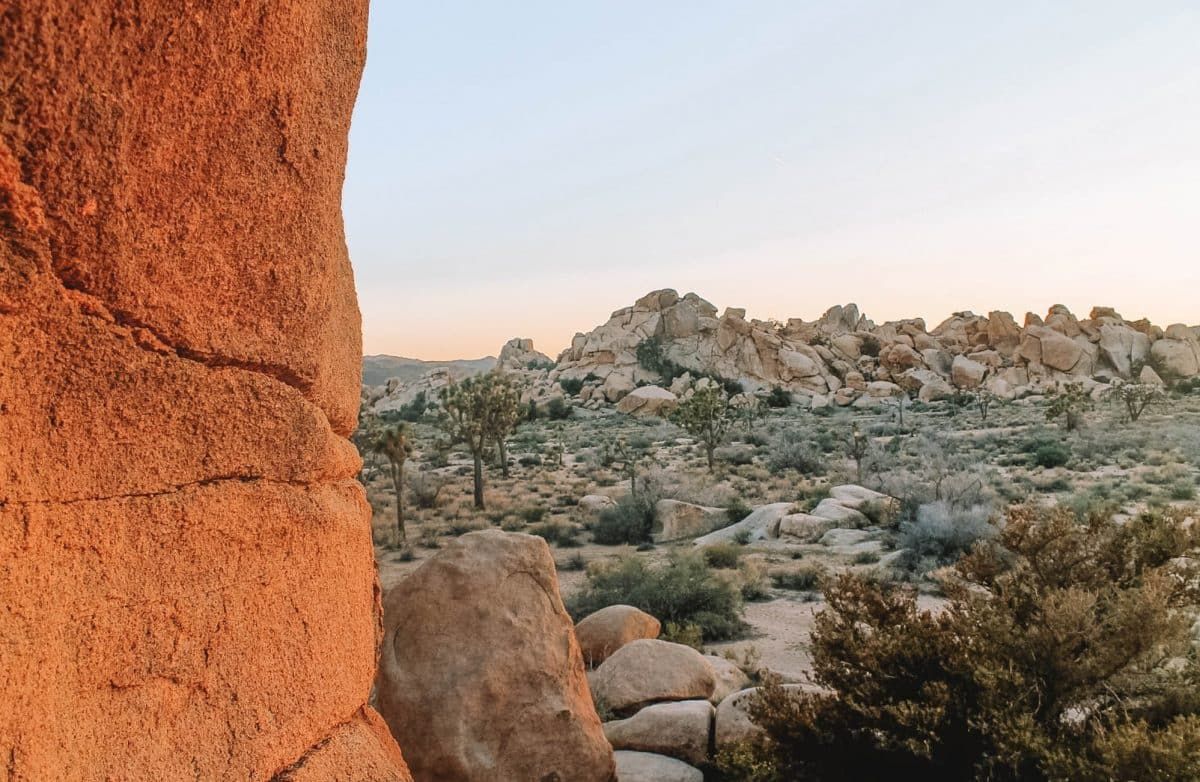
Why it’s worth camping at: Hidden Valley is one of the most popular campgrounds for climbers.
Location: Central Joshua Tree
Open: All year-round
Number of sites: 44
Cost: $15
Reservations allowed: No, first-come, first-served campsites only.
Amenities: Pit toilets, fire pits, and picnic table. No drinking water, no RV hookups, and no showers.
Campground map
Hidden Valley Campground is another centrally located campground in J-Tree surrounded by popular climbing routes.
Since Hidden Valley campground is first-come, first-served, it can be pretty hard to get a site here.
But if you do manage to get into Hidden Valley, you’ll have access to tons of classic hikes like Barker Dam, Boy Scout Trail, and the Hidden Valley Nature Trail.
Belle Campground
Why it’s worth camping at: Close access to Arch Rock and Skull Rock.
Location: North park entrance
Open: Early September-Late May
Number of sites: 18
Cost: $15
Reservations allowed: No, first-come, first-served campsites only.
Amenities: Pit toilets, fire pits, and a picnic table. No drinking water, no RV hookups, and no showers.
Campground map
The Belle Campground is the northernmost campground on Pinto Basin Road, situated amongst huge boulders and Joshua Trees.
It’s near two well-known rock formations: Arch Rock and Skull Rock.
Belle Campground is a first-come, first-served campground. Although some people say the campsites are rather small here, they can fit RVs up to 35 feet in length.
White Tank Campground
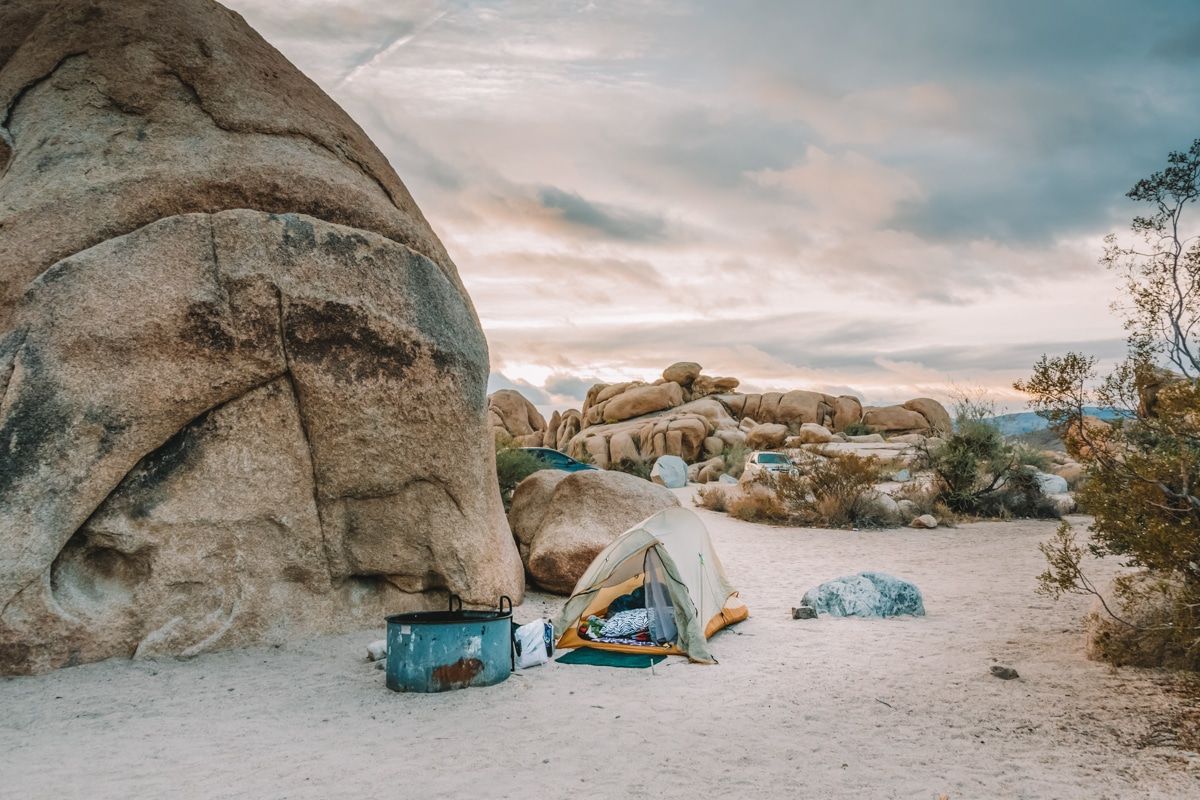
Why it’s worth camping at: It has fantastic stargazing.
Location: North park Entrance
Open: Early September-Late May
Number of sites: 15
Cost: $15
Reservations allowed: No, first-come, first-served.
Amenities: Pit toilets, fire pits, and a picnic table. No drinking water, no RV hookups, and no showers.
Campground map
White Tank Campground is just south of Belle Campground and is likewise a primitive, first-come, first-served campground surrounded by huge boulders.
While all of Joshua Tree is a designated international dark-sky park, White Tank Campground is said to have particularly stunning stargazing with spacious sites to spread out in.
Note that RVs longer than 25 feet can’t access this campground.
Indian Cove Campground
Why it’s worth camping at: Indian Cove is less crowded than the other big campgrounds.
Location: North Joshua Tree
Open: Early September-Late May
Number of sites: 101, including 13 sites for groups.
Cost: $25
Reservations allowed: Yes, click here to reserve.
Amenities: Pit toilets, fire pits, and a picnic table. No water, no RV hookups, and no showers.
Campground map
Indian Cove Campground is in the northern part of the park, about halfway between the West and North Entrances.
Unfortunately (or fortunately), neither of the big park roads will take you to Indian Cove Campground. You’ll have to take Indian Cove Road to the park from Twentynine Palms, CA.
Indian Cove is also one of three campgrounds in the park with group sites.
Perhaps because of the inconvenience of getting to Indian Cove, the campground can be less crowded than some of the other biggies.
Cottonwood Campground
Why it’s worth camping at: It has excellent wildflower viewing in the spring.
Location: South Entrance
Open: Early September-Late May
Number of sites: 62, including three group sites.
Cost: $25
Reservations allowed: Yes, click here to reserve.
Amenities: Flush toilets, a fire pit, a picnic table, drinking water, and RV dump station, but no showers.
Campground map
Cottonwood Campground on the park’s south border is situated amongst scraggly mesquite bushes and has a small area reserved for group campsites.
This campground is wonderful for viewing the spring wildflower bloom and is near the trailhead for Mastodon Peak and Lost Palms Oasis.
One other distinct benefit of this campground is the running water.
Sheep Pass Campground
Why it’s worth camping at: It’s a good place for a family reunion since it is a group-only specific campground.
Location: Central Joshua Tree
Open: All year
Number of sites: 6 tent-only sites.
Cost: $35-$50 depending on group size.
Reservations allowed: Yes, click here to reserve.
Amenities: Pit toilets, a fire pit, and a picnic table. No drinking water, no RV dump station, and no showers.
Campground map
If you’re looking to plan a family reunion in J-Tree, Sheep Pass Campground might be for you.
This campground is located just off Park Boulevard in central Joshua Tree and is the only campground explicitly designated for large groups.
This campground is for tents only so, unfortunately, the grandparents can’t bring their RV.
Best Backcountry Campgrounds in Joshua Tree National Park
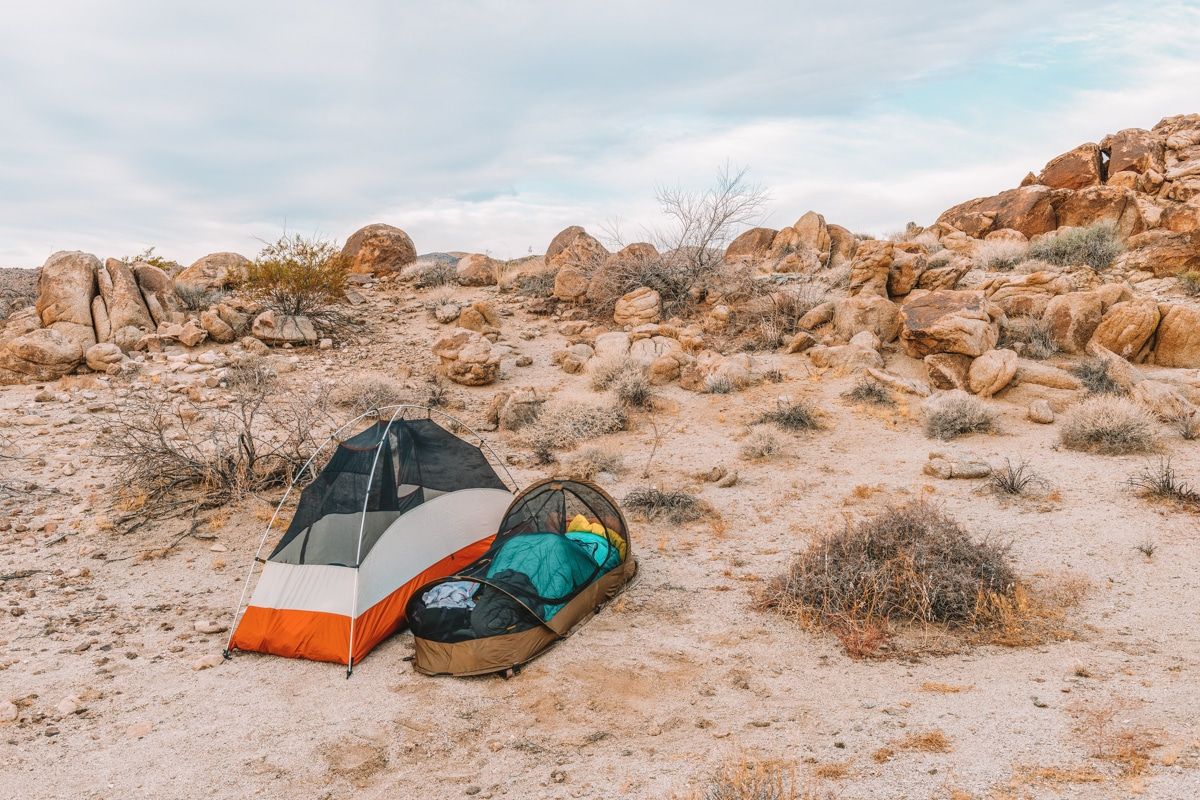
Joshua Tree doesn’t have any backcountry campgrounds, per se, but they have almost unlimited backpacking opportunities.
Generally, you can camp anywhere in the backcountry so long as you’re more than one mile from a road, 500 feet from water and trails, and not in a day-use-only area.
Note that you cannot camp in your car along the road, and if you don’t fill out a backcountry permit and leave the stub on your dashboard, they may tow your vehicle.
Thankfully, J-Tree has a pretty lax system for obtaining backcountry permits, and they’re free to boot.
All you need to do is register in person at one of the 13 backcountry registration boards throughout the park.
Joshua Tree is another one of those parks, like Death Valley, that doesn’t have an extensive system of backcountry trails. That said, it does have a handful of popular routes.
California Hiking and Riding Trail
The California Hiking and Riding Trail is a 36.5-mile trail running between the park’s West and North Entrances.
This trail is relatively flat, and passes by the Ryan, White Tank, Hidden Valley, Jumbo Rocks, and Belle Campgrounds.
However, these campgrounds are often full, so you may still need to disperse camp on your own.
Because it’s an out-and-back trail, you’ll need to arrange a vehicle shuttle at your destination and bring tons of water. It takes most people 2-4 days to hike this trail.
Boy Scout Trail
The Boy Scout Trail is a difficult eight-mile out-and-back trail and a popular backpacking route or day hike in the park.
You can start at Keys West Trailhead or the Indian Cove Campground, but it’s more downhill if you start at Indian Cove. It takes most people 4-6 hours to complete this trail.
Tips for Backcountry Camping in Joshua Tree
- Bring 4-6 liters of water per person per day. There’s little/no natural water in Joshua Tree and backpackers aren’t allowed to use it because it’s reserved for the wildlife.
- Cache water: You’re allowed to leave yourself caches of water along your route for up to two weeks. Leave a label with the date, your name, and phone number on your water jug. Popular cache locations are the front-country campgrounds along the route.
- If you’re hiking off-trail, leave a detailed itinerary with a friend who can call the park if you’re late coming out.
Free Camping in Joshua Tree National Park
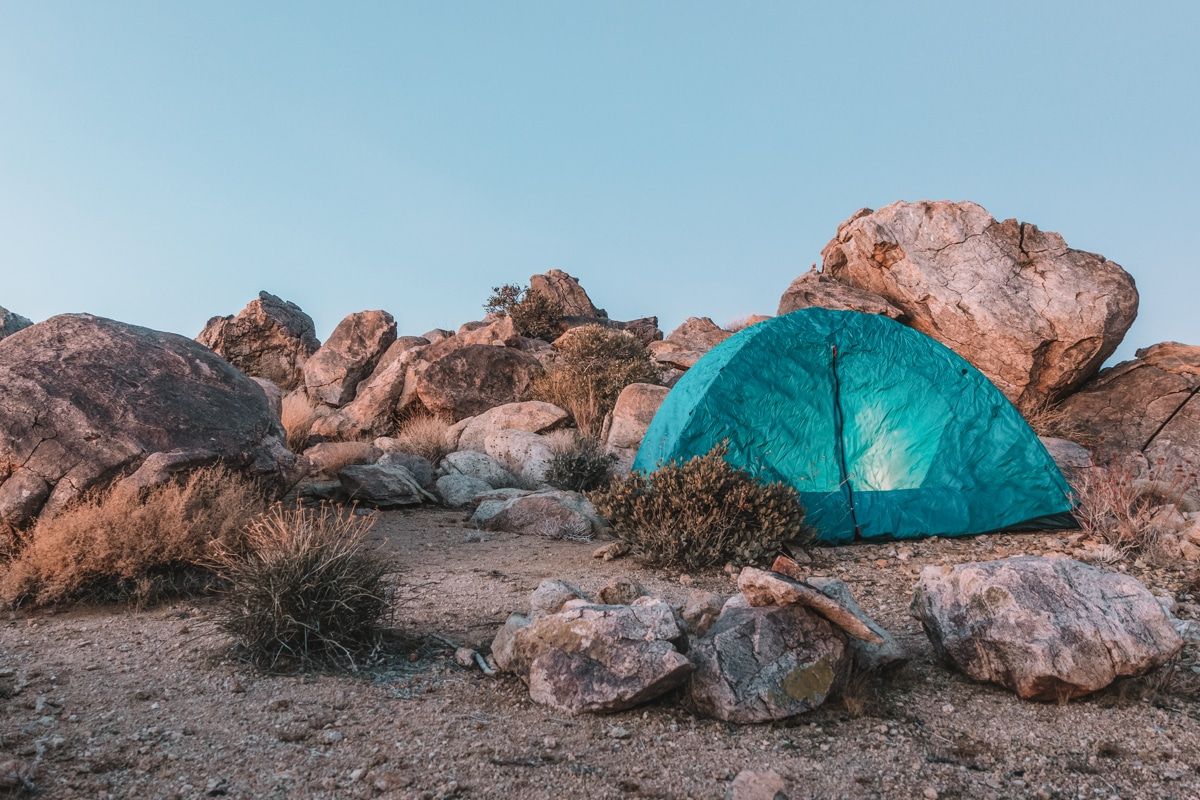
There’s free dispersed camping in J-Tree with a backpacking permit, but besides that, all the other campgrounds have a fee.
If “free” is the limit of your budget and you’re not down for backpacking, try these dispersed camping areas outside the park.
Note that you need a permit to have a fire on BLM land, and you’ll need to pack out all your trash.
BLM Camping North of Highway 62
Northeast of the Western Entrance at 66455 Broadway, Joshua Tree, CA 92252, you’ll find a plot of land operated by the BLM that is open for dispersed camping.
BLM Camping South of Cottonwood Spring
Just outside the South Entrance to the park at Cottonwood Spring Rd, Chiriaco Summit, CA 92201, you’ll find a few plots of land open for camping.
Since this area is farther away from the park’s central hub, you may find it less crowded here.
Campgrounds Near Joshua Tree: Best Camping Outside the Park
There’s plenty of camping near Joshua Tree, and you’ll find that many of these campgrounds have more amenities (or at least running water).
North Joshua Tree
The northern section of Joshua Tree is the busiest. It’s the best place to camp if you’re coming from Los Angeles, Las Vegas, or Death Valley.
Here you’ll find the adjoining towns of Joshua Tree and Twentynine Palms.
Joshua Tree Lake RV and Campground: If your ears perked up when I mentioned added amenities, Joshua Tree Lake RV and Campground might be for you. RV hookups, fishing, WiFi, dump station, and showers (even for non-overnight guests) are available here.
Little Pioneertown RV: This RV-only park includes full hookups, a clubhouse, laundry facilities, showers, and a shared outdoor patio with a grill.
South Joshua Tree
This area of the park is more remote, but it’s the fastest route if you’re coming from San Diego. I drove through here at night once and was glad I didn’t have car trouble on that lonely highway.
Palm Springs/Joshua Tree KOA: Situated 10 miles from Palm Springs, this facility accommodates RVs and tents, plus cabins, glamping tents, and extended stay guests.
Joshua Tree Glamping
The glamping buzz around Joshua Tree is having a *moment.* If you’re looking for an especially picturesque camping experience, check one out.
Castle House Estate Glamping Yurt: This canvas glamping yurt sits on the property of the Castle House, itself a rentable overnight venue. This space has been featured on HGTV and includes a communal swimming pool and a cafe menu.
Desert Bubble: Okay, this space is so unique that I have to keep telling people about it. The main bubble room sits on a wooden platform with an outdoor bathroom, and patio space nearby.
For more glamping options, including Joshua Tree cabins or trailers, check out our guide to the best Joshua Tree Glamping Sites.
Or, if you’re looking for other accommodation options, read our guide to the best Joshua Tree hotels.
Joshua Tree Camping Tips
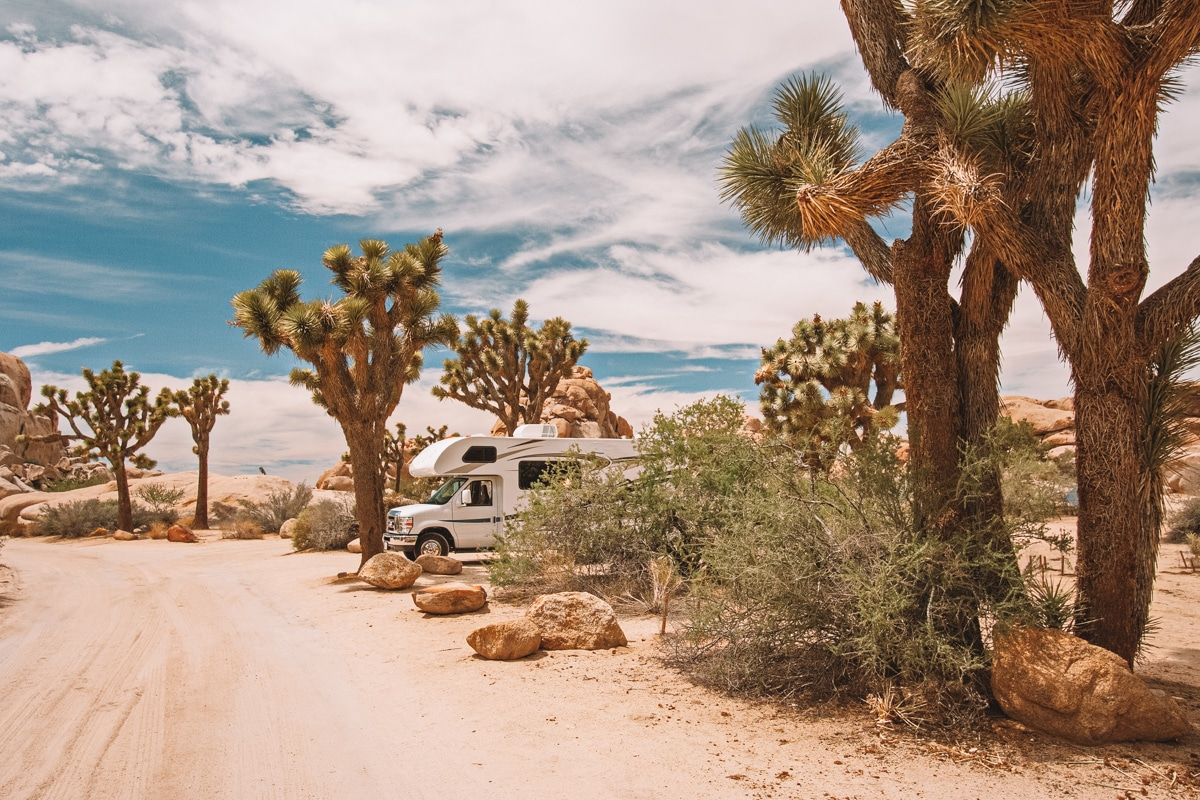
Avoid the Heat
The busy season for camping in Joshua Tree is late fall through early spring because it’s the only time it’s bearable to be outside. Even then, daytime temperatures can get into the 90s F.
In addition to camping in the peak season, you should plan to arrive early in the morning or late afternoon to avoid the hottest part of the day.
Set a Reminder Six Months in Advance to Reserve Your Site
I can’t usually make plans six months in advance, but if you want a site in a Joshua Tree campground, you should plan to set a reminder for six months before your vacay.
There’s no penalty to cancel the trip later on, and at least you’ll have a site saved.
First-come, first-served campgrounds usually fill by Friday afternoon or even Thursday afternoon on holiday weekends.
Utilize the Visitor Information Line
If you’re looking for up-to-date info about the park or available camping, you can call the Visitor Information Line (760-367-5500).
Rent an RV
I sleep well in hot weather, but most people I know think I’m crazy.
If you need your 67 degrees Fahrenheit to sleep, you should consider renting an RV or travel van in your city of origin.
Joshua Tree RV camping is definitely a thing and most campgrounds can fit RVs even if they don’t have hookups.
Plan to Ditch the Cell Phone
There’s no cell service in the park, like, anywhere.
There’s WiFi and cell service in nearby towns, but if you’re planning to navigate with your phone or have your camping reservations on your phone, get those pulled up ahead of time.
Respect the Joshua Trees!
Remember that Joshua Tree and other national parks protect natural and cultural resources.
None of the campgrounds in the park allow visitors to collect firewood or hang anything on the Joshua Trees.
Joshua Trees are surprisingly delicate and the rangers take this seriously. It’d be a bummer to get a ticket on your trip, so tread lightly!
Best Time to Camp in Joshua Tree National Park
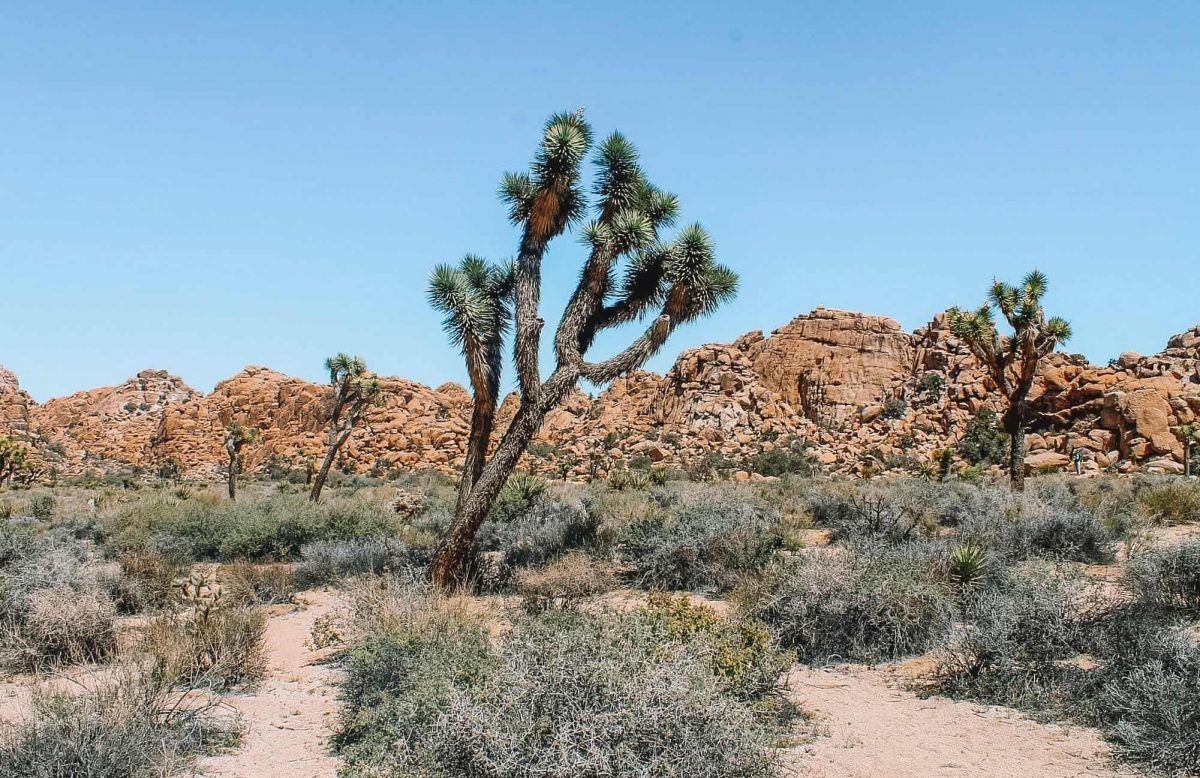
In my opinion, the best time to camp in Joshua Tree is early spring (late March to early June) because the temperature is cool and there’s a potential for wildflower blooms!
Note that this is everyone’s favorite time to camp in Joshua Tree (plus, it’s spring break season), so this is a particularly busy time in the park.
FAQs About Camping in Joshua Tree
Is Joshua Tree good for camping?
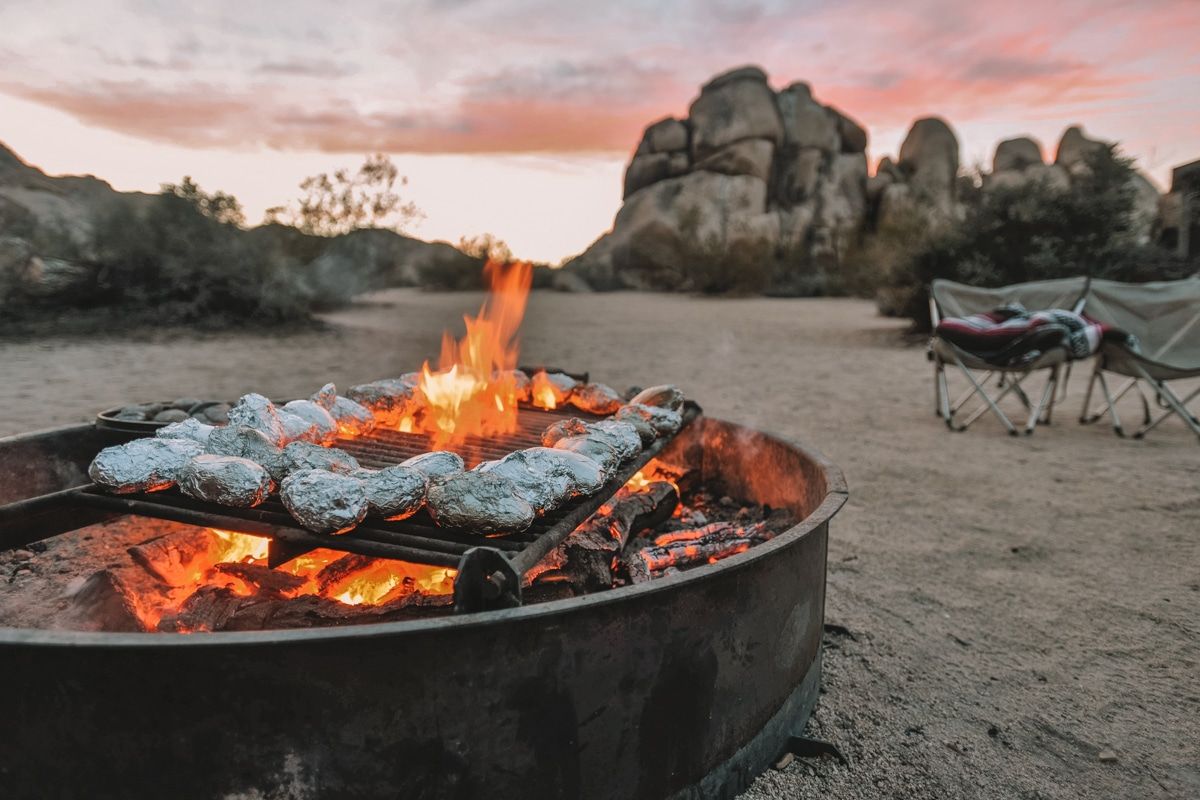
Yes, Joshua Tree is a fantastic place to camp, especially in fall, winter, and early spring.
Joshua Tree has nine campgrounds, including six you can reserve ahead of time and three that are first-come, first-served.
The park also offers endless free backcountry camping with a permit.
Can you camp anywhere in Joshua Tree?
In Joshua Tree, and most national and state parks for that matter, you cannot camp anywhere you like outside a designated campground. That said, there’s backcountry camping in most of Joshua Tree.
As long as you’re more than one mile from a road, 500 feet from water sources and trails, and not in a day-use only area, you can camp. Note that you cannot camp in your car along the roads.
How much does it cost to camp in Joshua Tree?
The Joshua Tree campsites cost between $15-$25 per night. Backcountry permits are free in Joshua Tree.
Which Joshua Tree campsite is best?
My favorite campsite in Joshua Tree is site #74 in Jumbo Rocks Campground because it’s tucked back amongst the boulders and desert vegetation.
Plus, the Jumbo Rocks Campground connects directly to the Skull Rock Trail.
Do you need a reservation to camp at Joshua Tree?
You need a reservation to stay in Black Rock, Cottonwood, Indian Cove, Sheep Pass, Jumbo Rocks, and Ryan campgrounds. And reservations are *highly* recommended to get the best campsites.
You also need a permit to camp in the backcountry. You don’t need a reservation to camp in Belle, Hidden Valley, and White Tank campgrounds, as they are first-come, first-served.
Can I sleep in my car at Joshua Tree?
You can sleep in your car at a designated campsite in Joshua Tree, but not in day-use parking lots, roads, or the backcountry.
Can you drink alcohol in Joshua Tree National Park?
You can have alcohol at your campsite, but you cannot bring an alcoholic drink into a building (which is true of most places, national parks or not).
Can you have a fire in Joshua Tree?
You can have a fire in metal fire rings or grills in designated campgrounds or picnic areas as long as there isn’t a fire ban in effect.
You can usually find postings about fire bans at the campground kiosk.
How do I plan a camping trip in Joshua Tree?
We have all you need for Joshua Tree trip planning!
Besides this detailed camping guide that should help get you started, read our other articles about the best things to do in Joshua Tree and the best hikes in Joshua Tree.
How many days do you need in Joshua Tree?
I would give yourself a minimum of two days in Joshua Tree, but three to four days for a better grasp on the place.
Looking to make your visit to Joshua Tree into a bigger road trip? Read our guide on how to get from Palm Springs to Joshua Tree or how to plan an epic California national park road trip.
What to Pack for Camping in Joshua Tree
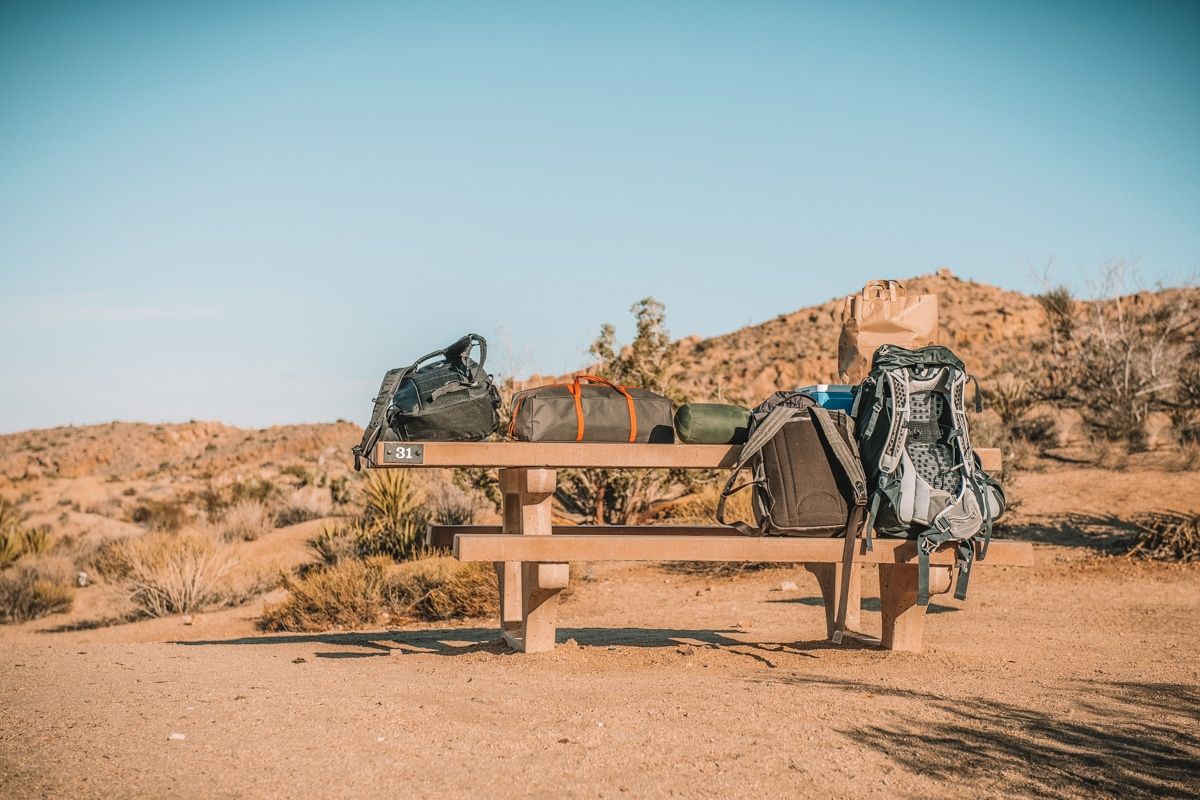
- Water plus electrolyte mix: My pro tip is two liters of water followed by one liter of electrolyte drink when recreating in the desert.
- Wide-brimmed hat: A ballcap is fine if that’s what you have, but seriously, wide-brimmed hats make *such* a huge temperature difference.
- Sun shirt with hood: A sun shirt is a lightweight SPF material, often with a hood, and is a major game-changer for summer adventures. They keep you cool and protect your skin, and you won’t end the day with that drained feeling.
- Long pants: I prefer wearing loose pants rather than leggings in the desert because they’re better protection from brushes with cacti.
- Sturdy hiking boots: There are too many pokey, stingy, and bitey critters in the desert to go in sandals.
- Cooler: For ice and to keep your drinks cold.
- Pop-up shade shelter: Most of the campgrounds in Joshua Tree are gorgeous but shade-free most of the day. Having your own camping canopy for shade is clutch.
- Sunscreen: Burnt skin is not *in*, girl!
- National Park Pass: to get those stamps.
ABOUT THE AUTHOR

Meredith Dennis
Meredith is a biologist and writer based in California’s Sierra Nevada. She has lived in 6 states as a biologist, so her intel on hiking and camping is *chef’s kiss* next level. One of her earliest camping memories was being too scared to find a bathroom at night on a family camping trip. Thankfully, she’s come a long way since then and she can help you get there too!
Looking for more California national park guides? Read our related articles below!
Sequoia National Park Camping Guide
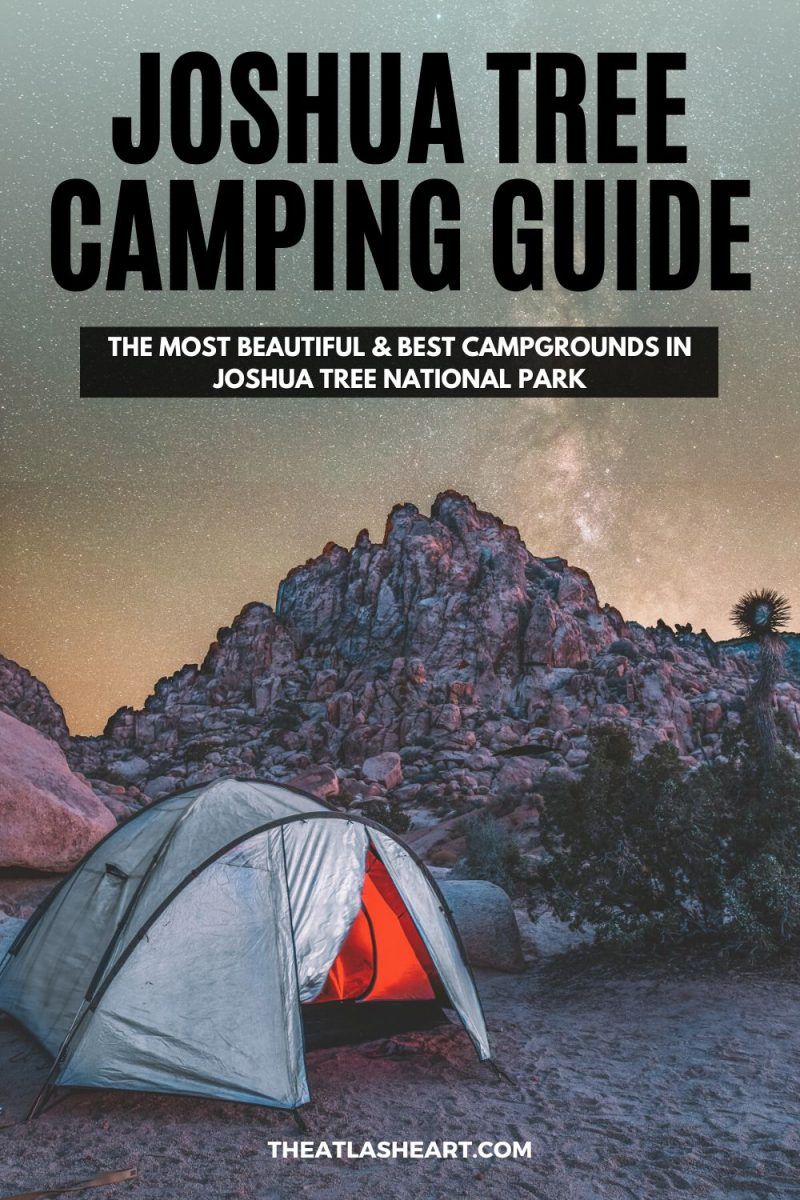
Pin this image for future reference

